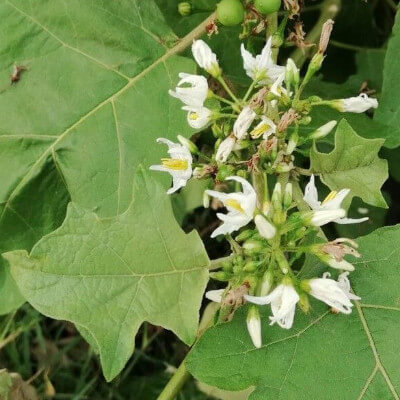
Solanum torvum, commonly known as the Turkey Berry, is a tropical plant with multiple facets, native to Central America and the Caribbean. This perennial shrub can grow up to three metres tall, with sturdy stems often covered in small spines. Its large leaves, with a slightly velvety texture, contribute to its distinctive appearance. In the botanical garden of the Au Bois Vert restaurant and lodge, located in Ivato near Antananarivo, this plant serves as a captivating example of tropical biodiversity.
The flowers of Solanum torvum, or Turkey Berry, grow in clusters and range in colour from pure white to delicate lavender. They play a crucial role in attracting essential pollinators such as bees and butterflies, thereby promoting cross-pollination. The fruits, initially green and globular, mature into golden yellow or brown hues. Although toxic to humans when raw, their presence in the ecosystem remains vital. Moreover, they serve as a food source for various animal species, helping to maintain a natural balance.
Finally, well adapted to tropical climates, this plant thrives in well-drained soils and warm temperatures. In the Au Bois Vert botanical garden, visitors can observe the Turkey Berry in a natural setting that highlights its ecological and aesthetic role. This species serves as a reminder of the importance of native plants in preserving ecosystems.
Plant use
Turkey Berry has long been used for its numerous medicinal properties and agricultural benefits. In traditional medicine, its leaves and fruits are prepared as infusions or decoctions, known for treating ailments such as hypertension, fever, and joint pain. However, these remedies require careful preparation to neutralise the toxic compounds naturally present in the plant. In some cultures, such preparations are also used to strengthen immunity and reduce inflammation. In agriculture, Solanum torvum is widely recognised as a valuable rootstock for other solanaceous crops, such as cultivated aubergines. This plant enhances crop resistance to diseases, such as wilts, and helps combat soil nematodes. Moreover, its robust root system prevents soil erosion in areas prone to degradation. Farmers in Ivato and the surrounding regions often integrate this species into their practices, highlighting its role in sustainable agricultural solutions. Furthermore, Turkey Berry is being studied for its potential applications in biological pest control. Its presence at the Au Bois Vert botanical garden serves as a reminder of the importance of preserving native species and promoting innovative, ecological solutions. Through its multiple uses, this tropical plant embodies a perfect balance between tradition and modernity.
Key information
| Common name | Turkey Berry |
| Scientific name | Solanum torvum |
| Origin | Central America and the Caribbean |
| Natural habitat | Tropical and subtropical regions |
| Life cycle | Perennial |
| Flowering period | All year round, with a peak in the wet season |


